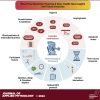Idiosyncratic bone responses to blood flow restriction exercise: new insights and future directions
- PMID: 37994414
- PMCID: PMC11212818
- DOI: 10.1152/japplphysiol.00723.2022
Idiosyncratic bone responses to blood flow restriction exercise: new insights and future directions
Abstract
Applying blood flow restriction (BFR) during low-load exercise induces beneficial adaptations of the myotendinous and neuromuscular systems. Despite the low mechanical tension, BFR exercise facilitates a localized hypoxic environment and increase in metabolic stress, widely regarded as the primary stimulus for tissue adaptations. First evidence indicates that low-load BFR exercise is effective in promoting an osteogenic response in bone, although this has previously been postulated to adapt primarily during high-impact weight-bearing exercise. Besides studies investigating the acute response of bone biomarkers following BFR exercise, first long-term trials demonstrate beneficial adaptations in bone in both healthy and clinical populations. Despite the increasing number of studies, the physiological mechanisms are largely unknown. Moreover, heterogeneity in methodological approaches such as biomarkers of bone metabolism measured, participant and study characteristics, and time course of measurement renders it difficult to formulate accurate conclusions. Furthermore, incongruity in the methods of BFR application (e.g., cuff pressure) limits the comparability of datasets and thus hinders generalizability of study findings. Appropriate use of biomarkers, effective BFR application, and befitting study design have the potential to progress knowledge on the acute and chronic response of bone to BFR exercise and contribute toward the development of a novel strategy to protect or enhance bone health. Therefore, the purpose of the present synthesis review is to 1) evaluate current mechanistic evidence; 2) discuss and offer explanations for similar and contrasting data findings; and 3) create a methodological framework for future mechanistic and applied research.
Keywords: blood flow restriction; bone remodeling; exercise; hypoxia.
Conflict of interest statement
No conflicts of interest, financial or otherwise, are declared by the authors.
Figures




Similar articles
-
Acute Neuromuscular Adaptations in Response to Low-Intensity Blood-Flow Restricted Exercise and High-Intensity Resistance Exercise: Are There Any Differences?J Strength Cond Res. 2018 Apr;32(4):902-910. doi: 10.1519/JSC.0000000000002022. J Strength Cond Res. 2018. PMID: 29570594 Clinical Trial.
-
Unilateral bicep curl hemodynamics: Low-pressure continuous vs high-pressure intermittent blood flow restriction.Scand J Med Sci Sports. 2015 Dec;25(6):770-7. doi: 10.1111/sms.12297. Epub 2014 Jul 23. Scand J Med Sci Sports. 2015. PMID: 25055880 Clinical Trial.
-
Blood flow restriction does not alter the early hypertrophic signaling and short-term adaptive response to resistance exercise when performed to task failure.J Appl Physiol (1985). 2023 May 1;134(5):1265-1277. doi: 10.1152/japplphysiol.00529.2022. Epub 2023 Apr 13. J Appl Physiol (1985). 2023. PMID: 37055038
-
Hypoxia and resistance exercise: a comparison of localized and systemic methods.Sports Med. 2014 Aug;44(8):1037-54. doi: 10.1007/s40279-014-0177-7. Sports Med. 2014. PMID: 24715613 Review.
-
Exercise with blood flow restriction: an updated evidence-based approach for enhanced muscular development.Sports Med. 2015 Mar;45(3):313-25. doi: 10.1007/s40279-014-0288-1. Sports Med. 2015. PMID: 25430600 Review.
Cited by
-
Blood flow restriction training in microgravity: a review of multisystem physiological benefits and implementation challenges for long-duration space missions.NPJ Microgravity. 2025 Aug 7;11(1):53. doi: 10.1038/s41526-025-00515-7. NPJ Microgravity. 2025. PMID: 40774988 Free PMC article. Review.
-
Blood flow modulation to improve motor and neurophysiological outcomes in individuals with stroke: a scoping review.Exp Brain Res. 2024 Dec;242(12):2665-2676. doi: 10.1007/s00221-024-06941-5. Epub 2024 Oct 5. Exp Brain Res. 2024. PMID: 39368025
-
Systematic review and meta-analysis of the effects of blood flow restriction training on bone health in older adults.Sci Rep. 2025 Apr 14;15(1):12800. doi: 10.1038/s41598-025-98053-5. Sci Rep. 2025. PMID: 40229395 Free PMC article.
-
How to Suppress Mineral Loss and Stimulate Anabolism in Postmenopausal Bones with Appropriate Timing of Exercise and Nutrients.Nutrients. 2024 Mar 7;16(6):759. doi: 10.3390/nu16060759. Nutrients. 2024. PMID: 38542671 Free PMC article. Review.
References
-
- Daly RM, Rosengren BE, Alwis G, Ahlborg HG, Sernbo I, Karlsson MK. Gender specific age-related changes in bone density, muscle strength and functional performance in the elderly: a-10 year prospective population-based study. BMC Geriatr 13: 71, 2013. doi:10.1186/1471-2318-13-71. - DOI - PMC - PubMed
-
- Wolff J. The Law of Bone Remodelling. Heidelberg: Springer, 1986.
Publication types
MeSH terms
Substances
LinkOut - more resources
Full Text Sources

